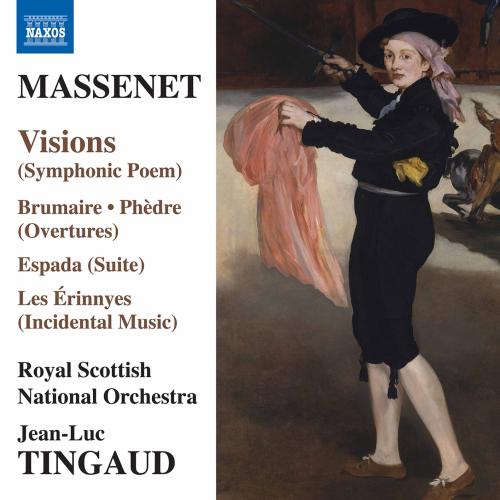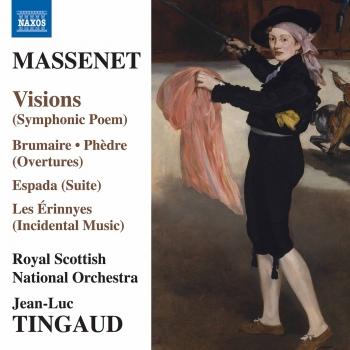
Massenet: Orchestral Works Royal Scottish National Orchestra & Jean-Luc Tingaud
Album info
Album-Release:
2020
HRA-Release:
09.10.2020
Label: Naxos
Genre: Classical
Subgenre: Orchestral
Artist: Royal Scottish National Orchestra & Jean-Luc Tingaud
Composer: Jules Massenet (1842-1912)
Album including Album cover Booklet (PDF)
- Jules Massenet (1842 - 1912):
- 1 Brumaire 10:05
- 2 Visions 14:05
- 3 Espada Suite: I. Panaderos 01:53
- 4 Espada Suite: II. Boléro 02:01
- 5 Espada Suite: III. Toréador et andalouse 03:43
- 6 Espada Suite: IV. La danse de la Mercédès 02:36
- 7 Les Érinnyes (1876 Version): I. Prélude 05:05
- 8 Les Érinnyes (1876 Version): II. Scène religieuse "Invocation" 07:35
- 9 Les Érinnyes (1876 Version): III. Entr'acte 04:45
- 10 Les Érinnyes (1876 Version): IVa. Divertissement. Allegro 05:09
- 11 Les Érinnyes (1876 Version): IVb. Divertissement. Andante 03:33
- 12 Les Érinnyes (1876 Version): IVc. Divertissement. Allegro très décidé 04:48
- 13 Phèdre: Overture 09:20
Info for Massenet: Orchestral Works
Jules Massenet is famous for his series of 27 operas that include Manon and Werther, but he also wrote a significant portfolio of orchestral music which include ballets, orchestral suites and incidental music. The works presented here show his versatility and lyricism and include the one-act ballet Espada, saturated in Iberian colour and beguiling rhythms, as well as Les Érinnyes (The Furies) with a vivid sequence of contrasting themes. Modelled after Liszt, Visions is a poème-symphonique of both ethereal and dramatic power.
"Massenet’s symphonic compositions reveal many aspects of his talent: incidental music inspired by Greek tragedy; ballet under Spanish influence; a romantic concert overture in Phèdre; and Brumaire, one of the discoveries of this album, a striking patriotic overture representing Napoleon’s coup, recorded here for the first time.
But the most fascinating aspect of his music for orchestra is to be found in his symphonic poem Visions, inspired by a journey into the Alps. Who would think of Massenet as the first composer to introduce electronic music in 1891 in his symphonic compositions? Visions has a line in the score for an Electrophone, an instrument invented a few months earlier, reproducing the human voice. Massenet used it to represent a departed loved one, heard from afar like a reminiscence. The piece also served as a sketch for his Thaïs meditation, producing a spacial effect of a small chamber group of solo violin and harp playing in dialogue with the full orchestra." (Jean-Luc Tingaud)
Royal Scottish National Orchestra
Jean-Luc Tingaud, conductor
Jean-Luc Tingaud
was born in 1969 and studied with Manuel Rosenthal, himself a pupil of Maurice Ravel. His concert engagements include performances with the Royal Philharmonic Orchestra, English Chamber Orchestra, Ulster Orchestra, Orchestra of Opera North, Orchestra Filarmonica Arturo Toscanini, Orchestra of the Teatro Carlo Felice, Genoa, Orchestra of the Teatro Massimo, Palermo, the Warsaw and Kraków Philharmonic Orchestras, Orchestre National des Pays de la Loire, Orchestre National de Lyon, and the Orchestre National de Lorraine.
The Royal Scottish National Orchestra
was formed in 1891 as the Scottish Orchestra and became the Scottish National Orchestra in 1950. It was awarded Royal Patronage in 1991. Throughout its history the orchestra has played an integral part in Scotland’s musical life. The RSNO has a worldwide reputation for the quality of its recordings, receiving two Diapason d’Or de l’année awards for Symphonic Music and eight GRAMMY® Awards nominations over the last decade.
Booklet for Massenet: Orchestral Works













